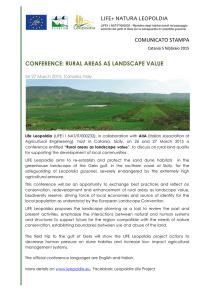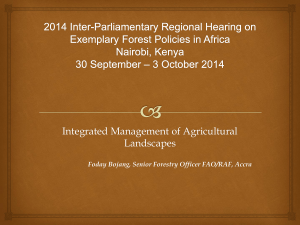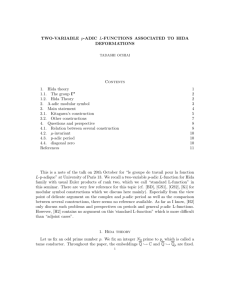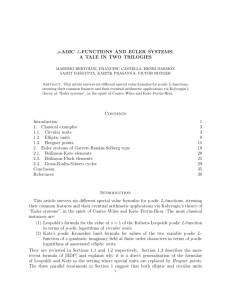Lecture 2
advertisement
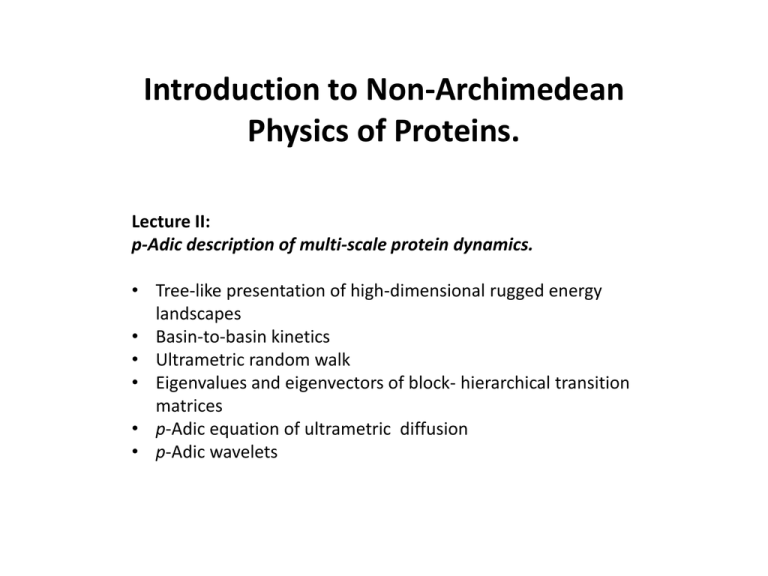
Introduction to Non-Archimedean
Physics of Proteins.
Lecture II:
p-Adic description of multi-scale protein dynamics.
• Tree-like presentation of high-dimensional rugged energy
landscapes
• Basin-to-basin kinetics
• Ultrametric random walk
• Eigenvalues and eigenvectors of block- hierarchical transition
matrices
• p-Adic equation of ultrametric diffusion
• p-Adic wavelets
How to define protein dynamics
Protein is a macromolecule
protein states
Protein states are defined by means of
conformations of a protein macromolecule.
A conformation is understood as the spatial
arrangement of all “elementary parts” of a
macromolecule.
Atoms, units of a polymer chain, or even
larger molecular fragments of a chain can be
considered as its “elementary parts”.
Particular representation depends on the
question under the study.
protein dynamics
Protein dynamics is defined by
means of conformational
rearrangements of a protein
macromolecule.
Conformational rearrangements
involve fluctuation induced
movements of atoms, atomic
groups, and even large
macromolecular fragments.
To study protein motions on the subtle scales, say, from
~10-9 sec, it is necessary to use the atomic representation
of a protein molecule.
Protein molecule consists of ~10 3 atoms.
Protein conformational states:
number of degrees of freedom : ~ 103
dimensionality of (Euclidian) space of states : ~ 103
In fine-scale presentation, dimensionality of a
space of protein states is very high.
Protein dynamics over high dimensional conformational space is
governed by complex energy landscape.
protein energy landscape
Given the interatomic interactions,
one can specify the potential energy
of each protein conformation, and
thereby define an energy surface
over the space of protein
conformational states. Such a
surface is called the protein energy
landscape.
As far as the protein polymeric chain is folded
into a condensed globular state, high
dimensionality and ruggedness are assumed to
be characteristic to the protein energy
landscapes
Protein energy landscape: dimensionality: ~ 103;
number of local minima ~10100
While modeling the protein motions on many
time scales (from ~10-9 sec up to ~100 sec), we
need the simplified description of protein
energy landscape that keeps its multi-scale
complexity.
How such model can be constructed?
Computer reconstructions of energy
landscapes of complex molecular
structures suggest some ideas.
Computer reconstruction of complex energy landscapes
Method
1.
Computation of local energy
minima and saddle points on the
energy landscape using
molecular dynamic simulation;
2.
Specification a topography of the
landscape by the energy
sections;
3.
Clustering the local minima into
hierarchically nested basins of
minima.
4.
Specification of activation
barriers between the basins.
potential energy U(x)
O.M.Becker, M.Karplus J.Chem.Phys. 106, 1495 (1997)
conformational space
B1
B2
B3
Presentation of energy landscapes by tree-like graphs
The relations between the basins
embedded one into another are
presented by a tree-like graph.
Such a tee is interpreted as a
“skeleton” of complex energy
landscape. The nodes on the border of
the tree ( the “leaves”) are associated
with local energy minima (quasi-steady
conformational states). The branching
vertexes are associated with the energy
barriers between the basins of local
minima.
potential energy U(x)
O.M.Becker, M.Karplus J.Chem.Phys. 106, 1495 (1997)
local energy minima
Complex energy landscapes: a fullerene molecule
Many deep local minima form the
basins of comparable scales.
Ground state:
attracting basin with a few deep
local minima.
C60
D.J.Wales et al. Nature 394, 758 (1998)
Complex energy landscapes : Lenard-Jones cluster
Many local minima
form basins of different
scales.
Ground state:
large attracting basin
with many local minima
of different depths.
LJ38
D.J.Wales et al. Nature 394, 758 (1998)
Complex energy landscapes : tetra-peptide
Many local minima form basins
of relatively small scales.
Ground state is not well defined:
there are many small attracting
basins.
O.M.Becker, M.Karplus J.Chem.Phys. 106, 1495 (1997)
Complex energy landscapes : 58-peptide-chain in a globular state
This is a small part of the energy landscape of a crambin
Tremendous number of local minima
grouped into many basins of
different scales.
Ground state is strongly degenerated.
Garcia A.E. et al. Physica D, 107, 225 (1997)
(reproduced from Frauenfelder H., Leeson D. T. Nature Struct. Biol.
5, 757 (1998))
Complex energy landscapes : a protein
The total number of minima on the
protein energy landscape is expected
to be of the order of ~10100.
This value exceeds any real scale in the
Universe. Complete reconstruction of
protein energy landscape is impossible
for any computational resources.
25 years ago, Hans Frauenfelder suggested a tree-like structure of the
energy landscape of myoglobin (and this is all what he sad)
Hans Frauenfelder, in Protein Structure (N-Y.:Springer
Verlag, 1987) p.258.
10 years later, Martin Karplus suggested the same idea
“In <…> proteins, for example, where individual
states are usually clustered in “basins”, the
interesting kinetics involves basin-to-basin
transitions. The internal distribution within a basin
is expected to approach equilibrium on a relatively
short time scale, while the slower basin-to-basin
kinetics, which involves the crossing of higher
barriers, governs the intermediate and long time
behavior of the system.”
Becker O. M., Karplus M. J. Chem. Phys., 1997, 106, 1495
This is exactly the physical meaning of protein ultrameticity !
That is, the conformational dynamics of a protein
molecule is approximated by a random process on
the boundary of tree-like graph that represents the
protein energy landscape.
Random walk on the boundary of a Cayley tree
Cayley tree is understood as
a hierarchical skeleton of
protein energy landscape.
The leaves are the local
energy minima, and each
subtree of the Cayley tree is
a basin of local minima.
The branching
vertexes are
associated with the
activation barriers for
passes between the
basins of local
minima.
w3
w2
w1
w3
Master equation
w2
w1
𝒇𝒊 is the transition probability, i.e. the probability to find a walker in a
state 𝒊 at instant 𝒕, and 𝒘𝒋𝒊 is the rate of transition from 𝒋 to 𝒊. The
energy landscape is represented by the transition rates 𝒘𝒋𝒊
Matrix description
Master equation
w3
d f i (t )
dt
w2
dt
1
w0
w1
w
2
w2
W
w
3
w3
w3
w
3
2
3
4
5
6
7
w1
w2
w2
w3
w3
w3
w0
w2
w2
w3
w3
w3
w2
w0
w1
w3
w3
w3
w2
w1
w0
w3
w3
w3
w3
w3
w3
w0
w1
w2
w3
w3
w3
w1
w0
w2
w3
w3
w3
w2
w2
w0
w3
w3
w3
w2
w2
w1
w
ji
f j (t )
ji
d F (t )
w1
W F ( t ),
w
ij
f i (t )
i j
F f 1 , f 2 ,..., f N
8
w3
w3
w3
w3
w2
w2
w1
w 0
Due to the basin-to-basin
transitions, transition matrix W has
a block-hierarchical structure.
For regularly branching tree, any
matrix element 𝒘𝒋𝒊, is indexed by the
hierarchy level of that vertex over
which the transition occurs
𝒘𝒋𝒊 = 𝒘𝒊𝒋 = 𝒘
Indexation of the transition matrix elements:
non-regular hierarchies with branching index p=2
𝜸 = 𝟐, 𝒏 = 𝟐
C (2,2)
B (1,2)
A (1,1)
1
2
3
4
5
6
7
2-adic (2-branching) Cayley tree:
each branching vertex is indexed by a pair
of integers (𝜸, 𝒏𝜸 ), where 𝜸 specifies the
level at which the vertex lies, and 𝒏
specifies the particular vertex over which
the transition occurs.
8
For example: A=(1,1), B=(1,2), C=(2,2).
Translation-non-invariant transition matrix
w 01
w
11
w 21
w 21
W
w
31
w 31
w
31
w
31
w11
w 21
w 21
w 31
w 31
w 31
w 02
w 21
w 21
w 31
w 31
w 31
w 21
w 03
w12
w 31
w 31
w 31
w 21
w12
w 04
w 31
w 31
w 31
w 31
w 31
w 31
w 05
w13
w 22
w 31
w 31
w 31
w13
w 06
w 22
w 31
w 31
w 31
w 22
w 22
w 07
w 31
w 31
w 31
w 22
w 22
w14
w 31
w 31
w 31
w 31
w 22
w 22
w14
w 08
The elements of the transition matrix W can
be indexed by the pairs of integers (𝜸, 𝒏𝜸 ).
𝒘𝒊𝒋 = 𝒘𝒋𝒊 = 𝒘𝜸𝒏𝜸
Indexation of the transition matrix elements:
random walk on 𝒑-branching Cayley tree, 𝒑 > 𝟐:
Given the transition 𝒊 → 𝒋 we, first, find a
minimal subgraph to which both sites 𝒊 and 𝒋
belong. In other words, we find a minimal
basin in which the transition 𝒊 → 𝒋 takes place.
This basin is presented by the particular
vertex (𝜸, 𝒏𝜸) lying on level 𝜸 of the tree.
Then, we go down to the lower lying 𝒑
𝟏
𝒑
subbasins 𝜸 − 𝟏, 𝒏𝜸−𝟏 , … , 𝜸 − 𝟏, 𝒏𝜸−𝟏
and find a particular pair of maximal
subbasins between which the transition 𝒊 → 𝒋
occurs.
Thus, the elements 𝒘𝒊𝒋 of the transition
matrix 𝐖 can be indexed by three integers, e.
g., by a pair (𝜸, 𝒏𝜸 ) that indicates the
smallest basin in which the transition occurs,
and an additional index 𝒌, 1 ≤ 𝒌 ≤ 𝒑 − 1,
that fixes a pair of the largest subbasins
between which the transition takes place.
𝒑=𝟑
𝛾
𝑛𝛾
𝒌=𝟏
𝒌=𝟐
𝒘𝜸𝒏𝒌
𝜸−𝟏
𝑗
𝑖
𝒘𝜸𝒏𝒌
𝒌 =2
𝑖
𝑗
𝒌=𝟏
The pair of subbasins that specifies
the transition from site 𝒊 to site 𝒋
over the vertex 𝜸, 𝒏𝜸
minimal basin 𝜸, 𝒏𝜸 in which
the transition takes place
Eigen vectors and eigenvalues
of symmetric block-hierarchical
transition matrices
Eigenvectors (ultrametric wavelets)
An eigenvector of a symmetric block-hierarchical
transition matrix specifying a random walk on 𝒑-adic
Cayley tree with 𝜞 levels, is a column vector that
consist of blocks of components according to the
hierarchy of basins. For each level 𝜸, there are (𝒑 −
𝟏)𝒑𝜸 eigenvectors 𝒆𝒑 (𝜸, 𝒏𝜸 , 𝒌). Each eigenvector
consists of 𝒑𝚪−𝜸 blocks with 𝒑𝜸 elements, and only
one block has nonzero components. The non-zero
block consists of 𝒑 sub-blocks with 𝒑𝜸−𝟏 identical
components in each. These components are the
complex numbers 𝒆𝒙𝒑 𝟐𝝅𝒊𝝓(𝜸, 𝒏𝜸 , 𝒌) such that the
sum of all components in non-zero block is equal to
0.
Thus, each eigenvector is indexed by a triple
(𝜸, 𝒏𝜸, 𝒌). The triple specifies the scale of nonzero
block in the column vector (𝒑𝜸 ) , the position of nonzero block in the column vector (𝒏𝜸 ), and the values
of non-zero components, 𝒆𝒙𝒑 𝟐𝝅𝒊𝝓(𝜸, 𝒏𝜸 , 𝒌) .
р=3: one of the 1st-level
eigenvectors
e 3 (1, 2, 2)
0
0
0
1
1
i
2
1
3
2
i
2
3
2
0
0
0
Examples:
Eigenvectors and eigenvalues of symmetric
block-hierarchical 2-adic transition matrix
d F (t )
W F (t )
d f i (t )
dt
dt
W e n n e n ;
F (t )
, n
w
ji
f j (t )
ji
n
w
ij
f i (t )
i j
(0) e n exp{ n t }
energy barriers
3,1
2,2
2,1
1,2
1,3
1,1
1
2
3
4
5
6
1,4
7
8
w 01
w
11
w 21
w 21
W
w
31
w 31
w
31
w
31
w11
w 21
w 21
w 31
w 31
w 31
w 02
w 21
w 21
w 31
w 31
w 31
w 21
w 03
w12
w 31
w 31
w 31
w 21
w12
w 04
w 31
w 31
w 31
w 31
w 31
w 31
w 05
w13
w 22
w 31
w 31
w 31
w13
w 06
w 22
w 31
w 31
w 31
w 22
w 22
w 07
w 31
w 31
w 31
w 22
w 22
w14
w 31
w 31
w 31
w 31
w 22
w 22
w14
w 08
p=2
four 1st-level eigenvectors
w 01
w
11
w 21
w 21
W
w
31
w 31
w
31
w
31
w11
w 21
w 21
w 31
w 31
w 31
w 02
w 21
w 21
w 31
w 31
w 31
w 21
w 03
w12
w 31
w 31
w 31
w 21
w12
w 04
w 31
w 31
w 31
w 31
w 31
w 31
w 05
w13
w 22
w 31
w 31
w 31
w13
w 06
w 22
w 31
w 31
w 31
w 22
w 22
w 07
w 31
w 31
w 31
w 22
w 22
w14
w 31
w 31
w 31
w 31
w 22
w 22
w14
w 08
1
1
0
0
e 1,1
,
0
0
0
0
0
0
1
1
e 1,2
,
0
0
0
0
0
0
0
0
e 1,3
,
1
1
0
0
four 1st-level eigenvalues
(3,1)
11 2 w11 2 w 21 4 w 31
12 2 w12 2 w 21 4 w 31
(2,2)
(2,1)
13 2 w13 2 w 22 4 w 31
(1,2)
(1,3)
(1,1)
1
2
3
4
5
6
(1,4)
7
8
14 2 w13 2 w 22 4 w 31
0
0
0
0
e 1,4
0
0
1
1
p=2
two 2nd -level eigenvectors
w 01
w
11
w 21
w 21
W
w
31
w 31
w
31
w
31
w11
w 21
w 21
w 31
w 31
w 31
w 02
w 21
w 21
w 31
w 31
w 31
w 21
w 03
w12
w 31
w 31
w 31
w 21
w12
w 04
w 31
w 31
w 31
w 31
w 31
w 31
w 05
w13
w 22
w 31
w 31
w 31
w13
w 06
w 22
w 31
w 31
w 31
w 22
w 22
w 07
w 31
w 31
w 31
w 22
w 22
w14
w 31
w 31
w 31
w 31
w 22
w 22
w14
w 08
(3,1)
21 4( w 21 w 31 )
(2,1)
1
2
3
4
22 4( w 22 w 31 )
(1,3)
(1,1)
5
0
0
0
0
e 2,2
1
1
1
1
two 2nd-level eigenvalues
(2,2)
(1,2)
1
1
1
1
,
e 2,1
0
0
0
0
6
(1,4)
7
8
p=2
w 01
w
11
w 21
w 21
W
w
31
w 31
w
31
w
31
w11
w 21
w 21
w 31
w 31
w 31
w 02
w 21
w 21
w 31
w 31
w 31
w 21
w 03
w12
w 31
w 31
w 31
w 21
w12
w 04
w 31
w 31
w 31
w 31
w 31
w 31
w 05
w13
w 22
w 31
w 31
w 31
w13
w 06
w 22
w 31
w 31
w 31
w 22
w 22
w 07
w 31
w 31
w 31
w 22
w 22
w14
w 31
w 31
w 31
w 31
w 22
w 22
w14
w 08
one 3rd -level eigenvector
1
1
1
1
e 3 ,1
1
1
1
1
(3,1)
one 3rd -level eigenvalue
(2,2)
31 8 w 31
(2,1)
(1,2)
(1,3)
(1,1)
1
2
3
4
5
6
(1,4)
7
8
p=2
eigenvector of the equilibrium state
eigenvalue of the equilibrium state
1
1
1
1
e0
1
1
1
1
0 0
Simple rule:
eigenvalue is the total rate to
exit particular basin
formula for non-zero eigenvalues: (p=2)
( m ax , n
1
, n 2 w , n (1 2 )
m ax
)
( 1, n )
2 w n
p-Adic description of
ultrametric random walk
The basic idea:
In the basin-to-basin approximation, the distances between the
protein states are ultrametric, so they can be specified by the padic numerical norm, and transition rates can be indexed by the
p-adic numbers.
Parameterization of ultrametric lattice by p-adic numbers
V.A.Avetisov, A.Kh.Bikulov, S.V.Kozyrev J.Phys.A:Math.Gen. 32, 8785 (1999)
ultrametric lattice
1
2
0
1
3
4
5
6
7
8
1/2
3/2
1/4
5/4
3/4
7/4
Cayley tree is a graph of ultrametric
distances between the sites. At the same
time, this tree represents a hierarchy of
basins of local minima on the energy
landscape.
22
T he lattice sites i 1, 2,..., p , is param eterized by a set
X of rational num bers x
(i)
such that the p -adic norm of
difference betw een any tw o sites x
|x
(i)
x
( j)
|p p
(i, j )
(i)
and x
( j)
21
,
, is the ultram etri c distance
20
betw een them .
T he set X is calculated using a sim ple re flection
i 1 p
1
a
(i)
1
p
p a p
ultrametric distances
between the sites
(i)
x
(i)
X
0
1
1\2
3\2
1/4
5/4 3/4
7/4
1
1 2
3 4
0
2 ,
5 6
7 8
1, 2 3, 4
5, 6 7, 8
2
1
,
1,2,3,4 5, 6, 7, 8
2
2
р-adic equation of ultrametric diffusion
Avetisov V A, Bikulov A Kh , Kozyrev S V . Phys.A:Math.Gen. 32, 8785 (1999);
master equation of random walk on ultrametric lattice
d f i (t )
dt
w ji f j ( t )
ji
d F (t )
Arrhenius law connects
mathematics and physics:
𝒘( 𝒙 − 𝒚 𝒑 )~𝐞𝐱𝐩 −
w ij f i ( t )
i j
W F ( t ),
dt
𝑬(|𝒙−𝒚|𝒑 )
𝒌𝑻
F f 1 , f 2 ,..., f N
energy landscape
•
parameterization of the lattice states {𝒊} by
rational numbers 𝒙 ∈ 𝑿;
•
specification of the transition rates 𝒘𝒊𝒋 as a
function on ultrametric distance, 𝒘(|𝒙 − 𝒚|𝒑 )
continuous limit 𝑿 ⇒ ℚ𝒑
•
f ( x, t )
t
p0
w (| x y | ) f ( y , t )
p
p1
f ( x, t ) d p y
Qp
x , y Q p , t R , f ( x , t ): Q p R R is the transition probability density, w (| x - y | p )
is the transition rate betw een states x a nd y , and d p x is the H aare m easure on Q p .
p3
Thus, we can consider the p-adic equation of
ultrametric random walk as a model of
macromolecular dynamics on particular energy
landscape
f ( x, t )
t
w (| x y | ) f ( y , t )
p
f ( x, t ) d p y
Qp
In fact, this p-adic equation describes very well the
complicated protein dynamics on many time scales
Eigenvectors of block-hierarchical transition
matrixes is described by p-adic wavelets
,n ,k p
w here
Z,
2
z
e
2 i p
1
k ( x p
n)
| p x n | p
is the fractional part of z Q p ,
n Qp / Z p,
k 1,..., p 1
0
0
0
1
1
3
e 3 (1, 2, 2 )
i
2
2
1 i 3
2
2
0
0
0
p=2
1st-level eigenvector
w 01
w
11
w 21
w 21
W
w
31
w 31
w
31
w
31
w11
w 21
w 21
w 31
w 31
w 31
w 02
w 21
w 21
w 31
w 31
w 31
w 21
w 03
w12
w 31
w 31
w 31
w 21
w12
w 04
w 31
w 31
w 31
w 31
w 31
w 31
w 05
w13
w 22
w 31
w 31
w 31
w13
w 06
w 22
w 31
w 31
w 31
w 22
w 22
w 07
w 31
w 31
w 31
w 22
w 22
w14
w 31
w 31
w 31
w 31
w 22
w 22
w14
w 08
1st-level wavelet
(3,0)
1,1 / 8
(2,1/8)
(2,0)
(1,1/4)
(1,1/8)
(1,0)
0
(1,3/8)
1/2 1\4 3\4
1/8
0
0
0
0
e 1,3
1
1
0
0
5/8 3/8
7/8
1
2
e
2 i ( x 1 / 8 )
2
1, x 1 / 8 ( i 5)
1, x 5 / 8 ( i 6)
1
| x 1 / 8 |2
p=2
2nd -level eigenvector
w 01
w
11
w 21
w 21
W
w
31
w 31
w
31
w
31
w11
w 21
w 21
w 31
w 31
w 31
w 02
w 21
w 21
w 31
w 31
w 31
w 21
w 03
w12
w 31
w 31
w 31
w 21
w12
w 04
w 31
w 31
w 31
w 31
w 31
w 31
w 05
w13
w 22
w 31
w 31
w 31
w13
w 06
w 22
w 31
w 31
w 31
w 22
w 22
w 07
w 31
w 31
w 31
w 22
w 22
w14
w 31
w 31
w 31
w 31
w 22
w 22
w14
w 08
0
0
0
0
e 2,2
1
1
1
1
(3,0)
2nd -level wavelet
(2,1/8)
2 ,1 / 8
(2,0)
(1,1/4)
(1,0)
0
1/2 1/4 3/4 1/8
(1,1/8)
5/8 3/8
(1,3/8)
7/8
1
2
e
2 i 2 ( x 1 / 8 )
2
1 , x 1 / 8, 5 / 8 ;
1 , x 3 / 8, 7 / 8 ;
2
| x 1 / 8 |2
i 5, 6
( i 7, 8)
p=2
w 01
w
11
w 21
w 21
W
w
31
w 31
w
31
w
31
w11
w 21
w 21
w 31
w 31
w 31
w 02
w 21
w 21
w 31
w 31
w 31
w 21
w 03
w12
w 31
w 31
w 31
w 21
w12
w 04
w 31
w 31
w 31
w 31
w 31
w 31
w 05
w13
w 22
w 31
w 31
w 31
w13
w 06
w 22
w 31
w 31
w 31
w 22
w 22
w 07
w 31
w 31
w 31
w 22
w 22
w14
3rd -level eigenvector
1
1
1
1
e 3 ,1
1
1
1
1
w 31
w 31
w 31
w 31
w 22
w 22
w14
w 08
(3,0)
3rd -level wavelet
(2,1/8)
3 ,0 2
(2,0)
(1,0)
0
(1,1/4)
(1,1/8)
1/2 1/4 3/4 1/8
(1,3/8)
5/8 3/8
7/8
1,
1,
3
2
e
2 i 2 x
2
| 2 x | p
3
x 0,1 / 2 ,1 / 4, 3 / 4;
x 1 / 8, 5 / 8, 3 / 8, 7 / 8;
( i 1, 2, 3, 4)
( i 5, 6, 7, 8)
Given the transition rates 𝒘(|𝒙 − 𝒚|𝒑 ), i.e. a hierarchical skeleton
of the energy landscape, one can solve a Cauchy problem for the
p-adic equation of ultrametric diffusion:
f ( x, t )
t
w (| x y | ) f ( y , t )
p
f ( x, t ) d ( y ) ,
f ( x , 0) (| x | p )
Qp
and then calculate some observables using the solution 𝒇 𝒙, 𝒕 .
In many experiments, the dynamics is observed as a relaxation
process (survival probability)
S (t )
(| x | p )
f ( x, t ) d p x
Characteristic relaxations in complex molecular systems
V.A.Avetisov, A.Kh.Bikulov, V.Al.Osipov. J.Phys.A:Math.Gen. 36 (2003) 4239
“soft” (logarithmic) landscape
E (| x y | p ) ~ T0 ln(ln | x y | p ) ~ T 0 ln(ln p ) ~ T 0 l n ,
S t ~ e
t
T
T
0
, T T0
stretched exponent decay
self-similar (linear) landscape:
E (| x y | p ) ~ T0 ln | x y | p ~ T 0 l n p ~ T 0
S t ~ t
T T0
power decay
“robust” (exponential) landscape:
E (| x y | p ) ~ T0 | x y | p ~ T0 p
S t ~
T0
T ln t
logarithmic decay
( 1)
A type of relaxation suggests particular tree for tree-like
presentation of energy landscape
Power kinetics of CO rebinding to myoglobin and power broadening
of the spectral diffusion suggest that the activation barriers
between the basins of local minima linearly grow with hierarchical
level 𝜸.
Thus, the power-law relaxation typical for proteins suggests
the particular form of p-adic equation of protein dynamics:
f ( x, t )
t
Qp
( 1)
| x y |p
f ( y, t ) f ( x, t ) d p y , ~
T0
T
Summary:
p-Adic description of multi-scale protein dynamics is based on:
• Tree-like presentation of high-dimensional rugged energy
landscapes and basin-to-basin-kinetics.
• p-Adic description of ultrametric random walk on the
boundary of a p-branching Cayley tree.
• Particular form of the p-adic equation of ultrametric diffusion
given by the Vladimirov operator.
With the p-adic equation in hands, we can describe all
features of CO rebinding and spectral diffusion in proteins
Mb*
?
Mb1
protein conformational space
binding CO
P
X
f ( x, t )
t
?
Qp
( 1)
| x y |p
f ( y, t)
f ( x, t ) d p y ,
x, y Q p







